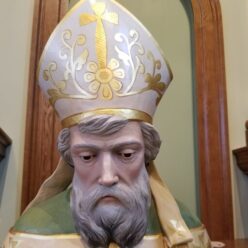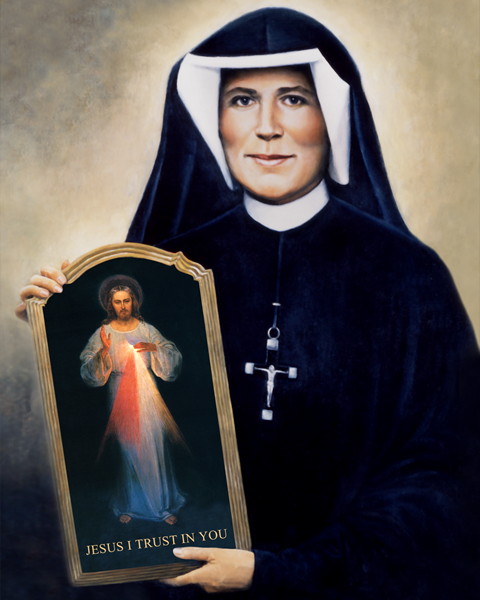
Saint Faustina
Date of Birth: 25 August 1905
Date of death: 5 October 1938
Beatified: 18 April 1993
Canonized: 30 April 2000
Feast Day: 5 October
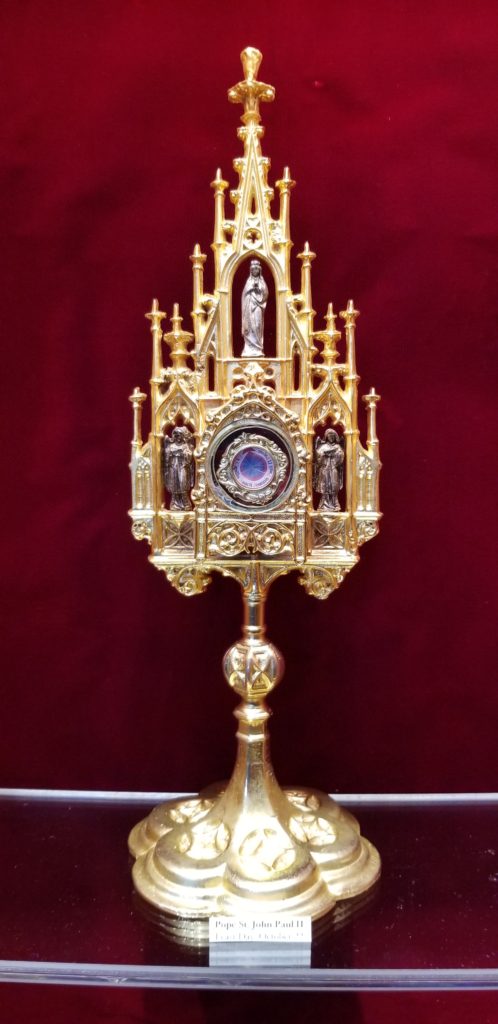
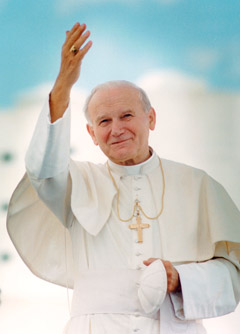
Pope Saint John Paul II
Date of birth: 18 May 1920
Date of death: 2 April 2005
Date of beatification: 1 May 2011
Canonized: 27 April 2014
Feast Day: 22 October
Saints Whose Relics are in the Altar of Sacrifice
Saint Paul of the Cross
January 3, 1694 – October 18, 1775 (aged 81). Founder of the Passionists, the Congregation of the Passion. Canonized in 1867; feast day is October 19 (Oct. 20 in the United States)
Saint Gabriel of Our Lady of Sorrows (born Francesco Possenti)
March 1, 1838- February 27, 1862 (aged 23) Passionist Seminarian; patron saint of gun owners and young people. Canonized in 1920; feast day on February 27.
Saint Gemma Galgani
March 12, 1878 – April 11, 1903 (aged 25). Laywoman, mystic, and stigmatist. Canonized in 1940; feast day is April 11.
Saint Simon Stock
1165 – May 16, 1265 (aged 100). General Superior of the Carmelites and recipient of the Carmelite Brown Scapular. Feast day is May 16.
Saint Maria Goretti (martyr)
October 16, 1890 – July 6, 1902 (aged 11).
Patron saint of purity, rape victims, and the youth in general.
Canonized in 1950; feast day is July 6.
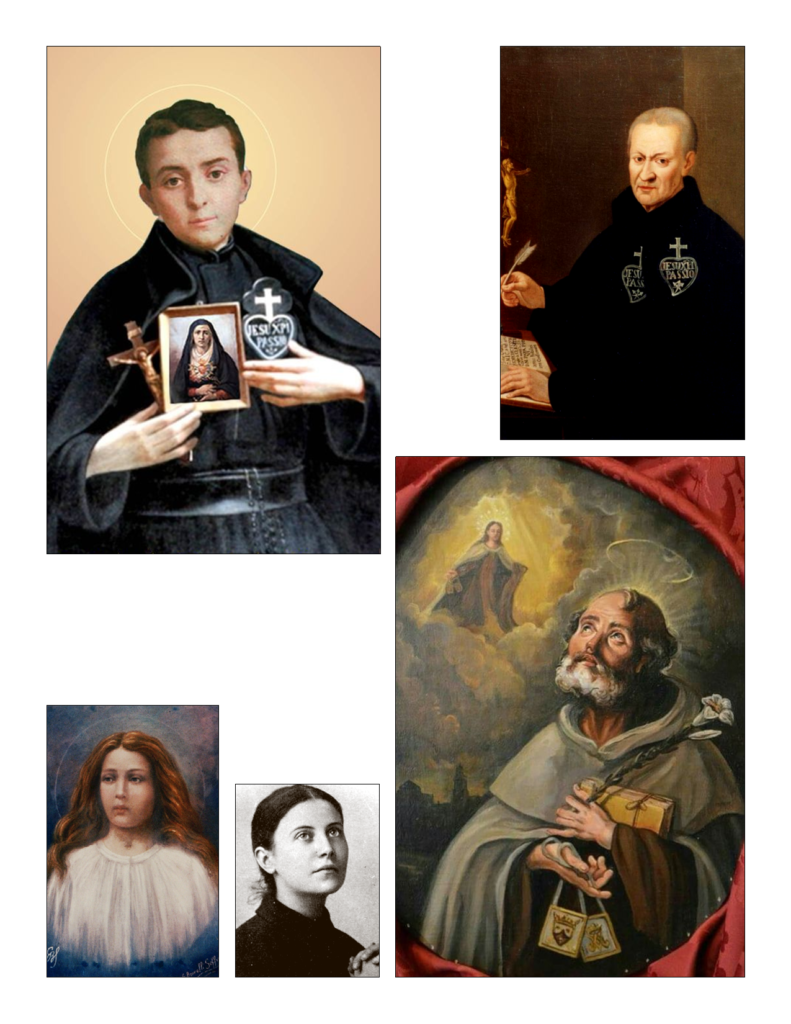
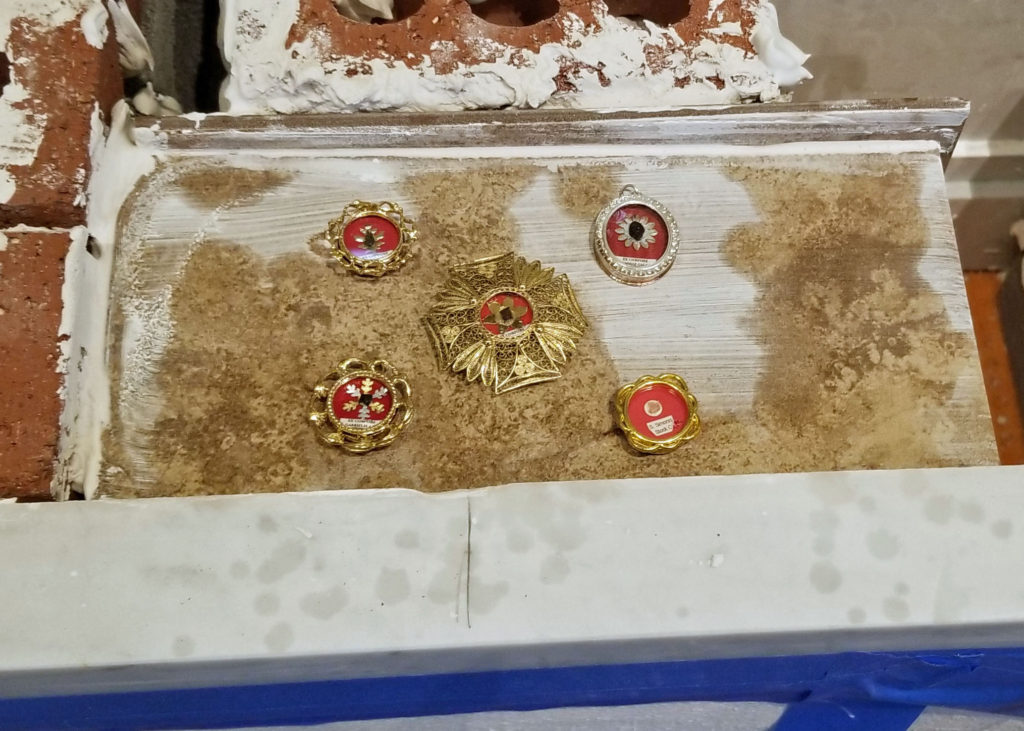
Our Lady of Fatima Shrine
Bl. Francisco Paulau y Quer Nov 7
Bl. Francisco Paulau lived his vocation as a Carmelite priest in 19th-century Spain during a time of persecution. Born in 1811, he entered the Carmelite novitiate in Barcelona in 1832. While he was a deacon, his monastery was burned and its inhabitants imprisoned. Upon their release, they were barred by the civil government from living their community life. However, Francisco Paulau persisted in the pursuit of his vocation and was ordained a priest in 1836. He lived in small grottos or hermitages as he moved frequently due to persecution by civil or ecclesiastical authorities. One day, he was accosted by four men seeking to kill him, and by God’s grace was able to guide their hearts from their murderous intentions to repentance. When the political situation took yet another turn for the worse in Spain, Fr. Francisco Paulau took refuge in France for eleven years. Returning to Spain in 1851, he founded The School of Virtue as a permanent method of catechesis for adults. Falsely accused of participating in workers’ strikes, Fr. Francisco Paulau again found himself in exile on a little island off the coast of Spain, where he found great communion with his God. This devoted priest also labored tirelessly to restore exorcism as a ministry, which had fallen by the wayside after the Enlightenment. Working to liberate souls for Christ from the grasp of demon influences, Fr. Francisco Paulau followed the example of Christ in casting out demons. In his final years, he nursed typhoid patients before succumbing to the illness himself on March 20, 1872. Despite wishing to be a martyr himself, his martyrdom was his life of nearly constant persecution, misunderstandings, and calumnies. His feast day is Nov. 7. He would be a good patron saint for persecuted religious, priests, exorcists, and victims of calumny. Bl. Francisco y Paulau y Quer was beatified by Pope John Paul II in 1988.
St. Pio of Pietrelcina Sept. 23
The miracle worker known around the world as Padre Pio was born Francesco Forgione on May 25, 1887, in Pietrelcina, Italy. He was one of eight children born to peasant farmers, Grazio and Maria. He was very devout as a young boy, serving mass and desiring to become a priest at the age of five. Up until the age of ten, he watched his father’s sheep in preparation for his vocation in tending the Lord’s flock. Due to his helping the family with the shepherding, his schooling needed extra attention before entering the Capuchin Franciscan Friars. Despite his poor health, he was ordained as a priest. He suffered often from illness and literal battles with the devil. Already a priest, Padre Pio was even drafted into the Italian Army in 1914 during World War I and served as a medic before being released due to his health issues. Padre Pio was most notably a spiritual medic for souls, by virtue of his priestly vocation, spending many hours in the confessional, reconciling sinners to God. In his earlier years, it was estimated he spent 15-19 hours a day in the confessional while in the 1940s and 50s he still spent five to eight hours hearing confessions. He was blessed with the ability to read souls, and remind people of the sins they were forgetting in the confessional. So many people came to him for confession that tickets had to be issued because the lines were so long. In August 1918, he received the wounds of the stigmata, which would remain with him for the next 50 years until a few days before his death on September 23, 1968, when they were miraculously cured. There are many stories about the bilocation of Padre Pio. One of the most notable ones was the case of an Allied bomber during WWII being waved away by a monk in the sky above San Giovanni Rotondo. When the pilot reported the incident, it was written off as fatigue. Among the good saint’s many admonitions: Some people are so foolish that they think they can go through life without the help of the Blessed Mother. Love the Madonna and pray the rosary, for her Rosary is the weapon against the evils of the world today. All graces given by God pass through the Blessed Mother. Also, Pray, hope, and don’t worry. Worry is useless. God is merciful and will hear your prayer. Padre Pio was canonized by Pope John Paul II on June 16, 2002.
Bl. Elisha of St. Clement May 29
Bl. Elisha was born in Bari, Italy on Jan. 17, 1901. She was baptized Theodora, which means gift of God, by her devout Catholic parents. On the night before her First Communion, she had a vision of St. Therese of Lisieux, who told her that she would be a sister like she was. Elisha became a Third Order Dominican in 1915. At the age of 19, she entered the Carmelite order. She wrote of her departure, Goodbye, my house, nest of peace and love, sweet sanctuary of faith and virtue, goodbye forever, I’m leaving you for my God. Lord, I’ve heard your voice, I’m flying to Carmel. At the age of 24, she gave herself completely to God. Having been weakened by a virulent influenza earlier in the year, Elisha succumbed to a high fever, and on Christmas Day in 1927 at the young age of 26, she passed into the arms of her Creator, whom she loved most ardently. Pope Benedict XVI beatified Bl. Elisha on March 18, 2006 Elisha of St. Clement May 29.
St. Maria del Sagrario Aug 16
Bl. Maria del Sagrario was a pharmacist, a Carmelite nun and a martyr of the Spanish Civil War. Elvira Cantarero was born to her parents in Toledo, Spain on January 8, 1881, the third of four children. Following her father’s footsteps into the field of pharmacy, she was one of the first women to become a pharmacist in Spain. Despite her talents in the pharmaceutical field, she discerned the call to a religious vocation. However, her father died in 1909 and her mother two years later. To this sister fell the task of caring for her younger brother until he could begin his career. While she waited to enter Carmel, she ran the pharmacy while personally nursing and encouraging the sick, as well as teaching catechism. Finally, the day arrived for her heart’s desire. She entered Carmel in Madrid in 1915. She was elected as prioress for the second time in July 1936 and later that month, the convent was attacked by a mob during the Spanish Civil War. Mother Maria Sagrario was able to help her sisters escape the mob to safe locations. Her brother pleaded with her multiple times to take refuge with his family, but she refused saying she needed to take care of her sisters. The following month, her hiding place with another sister was discovered and both were arrested. Mother Maria refused to betray anyone and was executed by a firing squad on the feast of the Assumption, 1936. She truly lived the words of Our Lord, Greater love hath no man than to lay down his life for his friends. She was beatified by Pope John Paul II in 1998.
Bl. Marie Rose Durocher Oct. 6
Bl. Marie Rose Durocher was born in Quebec, Canada to her parents, Olivier and Genevieve, on Oct. 6, 1811, the tenth of eleven children. They named their new daughter Eulalie Melanie. Three of her brothers would later enter the priesthood. Her parents were prosperous farmers and Eulalie grew to be a competent horse rider and named her horse Caesar. Illness interrupted her schooling with the Sisters of Notre Dame, so she returned home from boarding school at the age of 12 for tutoring at home. Again, at 16, she returned to the sisters for two years but was unable to be accepted into the novitiate there due to her poor health. In 1830, her mother passed away and the family moved to the parish house where her brother, Theophile, was a priest. She worked as his secretary and housekeeper for twelve years. During this time, Eulalie became acutely aware of the lack of educational opportunities for young girls. The French order, The Sisters of the Holy Names of Jesus and Mary, considered establishing a congregation in Quebec, but the plans never materialize. However, the bishop, realizing the eagerness of Eulalie and a few of her friends, encouraged her to lead a new congregation in Quebec by the same name. On February 28, 1844, Eulalie Durocher became Sister Marie Rose while her friends, Melodie Dufresne and Henriette Ceri took the names Sister Marie-Madeline and Sister Marie-Agnes. After their vows, they elected Sister Marie Rose to be Mother Superior. In the short span of five years, they established four convents where they taught English and French. Bl. Marie Rose experienced her share of troubles with a priest who wanted to manage her schools. Nevertheless, God gave her the grace she needed to carry on despite his badmouthing the sisters’ efforts. Bl. Marie Rose spent much of her life in ill health, and passed away at the age of 38 on Oct. 6, 1844, having spent her lifetime in the service of her God. She was beatified by Pope John Paul II on May 23, 1982.
Bl. Frederic Jansoone Aug. 4
On Nov. 19, 1838, Frederic Jansoone was the youngest of thirteen children born to his parents, Pierre-Antoine and Marie-Isabelle, who were prosperous farmers in Ghyvelde, France. As a child, he loved to visit his parish church and was often found praying on the farm. He was only nine years old when his father died in 1848, and by 1855, the family was experiencing hard times. Frederic left school to help support his siblings and widowed mother, but she, sensing a vocation in him, offered herself to God for his vocation. After his mother’s death in 1861, Frederic resumed his education He received the Franciscan habit in 1864 and was ordained a priest in 1870. Fr. Frederic served as a military chaplain at a hospital during the Franco-Prussian war. After the war, in 1876, he was permitted to go as a missionary to the Holy Land, where he was assigned to the Church of the Holy Sepulcher. At one point, he almost died from a severe illness, but the Lord had other plans for him. His life was to be filled with preaching, retreats, missions and assisting pilgrims. However, financial strains were very difficult in Palestine during this time, and Fr. Frederic offered to collect funds from abroad. The French gave a cold shoulder to his appeal in Paris, but a providential meeting with a fellow priest providentially pointed him in the direction of a much warmer reception in Quebec. Soon, his superiors dispatched him to establish a Holy Land Commissariat. Again, a severe illness brought him near death’s door, and again, he recovered. During his recovery, he was recalled to Jerusalem. In 1888, he returned to Quebec to finally establish the Holy Land Commissariat in Quebec. Fr. Frederic suffered many years from stomach cancer, never knowing what was causing his pain. After 50 days of intense suffering, Fr. Frederic passed away on Aug. 4, 1916 with the words Amen. Come, Lord Jesus, come! Fr. Frederic Jansoone was beatified on Oct. 25, 1988 by Pope John Paul II. His feast day is Aug. 4.
Bl. Maria Candida of the Eucharist June 12
Bl. Maria Candida was born Maria Barba in Catanzaro, Italy on Jan. 16, 1884, the tenth of twelve children (seven of whom lived to adulthood). Her parents, Pietro and Giovanna, moved the family back to their hometown of Palermo when she was two. Her father was a judge in the appellate court. From a very young age, Maria had a deep devotion to Jesus in the Eucharist. She wanted to receive Holy Communion so much that her mother would breathe on her after receiving Holy Communion so that she could receive Jesus too. She made her First Communion at the age of ten in 1894 and was overjoyed at the thought of receiving Jesus in the Holy Eucharist. After her cousin became a nun, she told her parents of her desire to do the same at the age of 15. Although her family was deeply religious, they were strongly opposed to the idea of a religious vocation for their daughter, thinking it fancy more than fervent desire. Following the deaths of her father in 1904 and her mother in 1914, she did not go out much by herself because of her brothers not wanting her to go out alone. To be deprived of frequent communion was a great cross for Maria. Brokenheartedly, Maria waited a full twenty years from that first time her desire for a religious vocation was expressed before she was able to enter Carmel in 1919 at the age of 35. Within five years, she was elected prioress and retained that position until 1947. Diagnosed that year with liver cancer, she suffered for months until her dear Lord called her home on June 12, 1949, which was the feast of the Holy Trinity. During her life she wrote her masterpiece entitled Eucharist: True Jewel of Eucharistic Spirituality. In it she wrote, I want to be like Mary,… to be Mary for Jesus, to take the place of His Mother. When I receive Jesus in Communion Mary is always present. I want to receive Jesus from her hands, she must make me one with Him. I cannot separate Mary from Jesus. Hail, O Body born of Mary. Hail Mary, dawn of the Eucharist! Bl. Maria Candida of the Eucharist was beatified on Mar. 21, 2004 by Pope John Paul II. Her feast day is June 12.
St. Teresa Margaret of the Sacred Heart Sept 1
St. Teresa Margaret of the Sacred Heart was baptized Anna Maria by her parents, the day after her birth, on the feast of Our Lady of Mt. Carmel in 1747. She was the second of fourteen children born to her parents, Ignatius and Camilla. Her parents were devout, and her father especially noticed and nurtured his daughter’s vocation by encouraging devotion to the Sacred Heart of Jesus. So great was her devotion, the sisters at her school in Florence allowed her to make her First Communion a year earlier than usual at the age of nine. At the young age of 17, she entered the Carmelite Monastery in 1764 and took the name Teresa Margaret of the Sacred Heart. She grew in charity and grace, taking care of her sick sisters in the infirmary. It was a shock to the monastery when she died at the age of 22, after a sharp and severe pain. Natural coloring returned to her body within two days and is still incorrupt. Bl. Margaret of the Sacred Heart was canonized by Pope Pius XI on March 19, 1934. Her feast day is September 1.
St. Gerard Majella Oct. 16
St. Gerard Majella, who is often invoked as the patron of the saint of expectant mothers, was born to Dominic and Benedetta Majella on April 26, 1726, in Muro, Italy. He was baptized on his birthday due to concerns about his health. His father was a tailor and passed away when Gerard was only 12. Due to the family’s impoverishment, he was sent away to live with his uncle since his mother had three other children to support. Shortly thereafter, Gerard was apprenticed to a tailor, who treated him kindly, although the foreman did not. After several years he was engaged as a servant to a cantankerous bishop. He divided his earnings between his mother, the poor, and offerings for the souls in purgatory. At the age of 23, Redemptorist missionaries traveled to his hometown; Gerard sought to join them but was turned away because of his poor health and lack of formal education. His mother, getting wind of this idea, was afraid he would run off with the missionaries and locked him in his room, hoping to stifle his vocational aspiration before the missionaries left town. However, trying to thwart God’s will never seem to work out, and Gerard tied his bedsheets together and escaped from his room out of the window. He did leave his mother a note letting her know that he was off to become a saint. Gerard’s mother was not the only one who didn’t have a clue about his vocation. The priest who finally let him join the order sent him with a note, “I am sending you a useless brother.” St. Gerard lived as a Redemptorist brother with two goals: love God and love your neighbor. He raised money for young women who wished to enter the convent because at that time a dowry was needed. One such woman who was helped by Gerard became homesick and left the convent, and then began gossiping about him due to her own embarrassment for leaving. Gerard was called in to answer the charges by St. Alphonsus Ligouri, but remained silent in the face of the false charges against him. Poor Gerard was even prohibited from receiving Holy Communion. Instead of becoming angry, his response was it is enough to have Jesus in my heart. The situation lasted nearly three months before the woman became seriously ill and wrote a letter retracting her calumny, thus clearing Gerard of any wrongdoing. Witnessing such patience and silence in the face of a false accusation, St. Alphonsus said of him, “Brother Gerard is a saint.” The humble man predicted to be a “useless brother” served Christ in the Redemptorist order as a tailor, an infirmarian and a porter; his spiritual advice was sought by many as he brought many souls back to God through his charity and holiness. While visiting a family one day shortly before his death, Brother Gerard dropped his handkerchief. One of the young daughters picked it up to return it to him. He told her to keep it as she might need it someday. Years later, when she was experiencing a dangerous childbirth, she remembered what Brother Gerard had said to her and asked for the handkerchief. The danger passed and her child was born healthy. St. Gerard kept his promise to his mother; he became a saint. At the age of 29 and suffering from tuberculosis, he passed into the arms of the Lord he had loved and served so well on October 16, 1755. He was canonized by Pope St. Pius X on December 11, 1904. He is the patron saint of mothers, expectant mothers, childbirth, children, unborn children, the pro-life movement, lay brothers, good confessions, and the falsely accused. His feast day is Oct. 16.
St. Maria of Jesus Crucified Aug 26
Mariam Baouardy was born on January 5, 1846, as the answer to her parents’ prayer. George Baouardy and Mariam Shahine were Lebanese Catholic parents whose twelve sons died in infancy. After the profound loss of so many children, they decided to make a pilgrimage to Bethlehem. In the words of the saint’s mother, Let us go to Bethlehem on foot, and ask the Blessed Virgin for a daughter. Let us promise her that if our prayers are answered, we will name her Mariam and will offer for the service of God a quantity of wax equal to her weight when she is three years old. Mariam was born on the eve of the Epiphany and her brother, Paul, two years later. The family’s earthly happiness was short-lived as her parents passed away from an infectious illness within a couple of days of each other before she was three. Mariam and her brother were raised by different relatives and never saw each other again on this earth. Mariam was treated kindly by her uncle until the day she spurned the idea of the marriage he had arranged for her at the age of 13. The night before the wedding, Mariam cut off her braids and entwined them around the jewels given to her by her fiancée. She told her uncle that the only spouse she wished to have was Jesus. Infuriated, he banished her to work in the kitchen as a servant. After several months of harsh treatment, Mariam sought to contact her brother with the help of a Muslim servant. He wished Mariam to convert to Islam and was so upset when she would not deny her faith that he slashed her throat in response; he left her for dead on the roadside. Mariam recalled she was nursed back to health by a nun in blue who fed her delicious soup. She later told her spiritual director, I know now that the religious who cared for me after my martyrdom was the Blessed Virgin. This was the beginning of her visions of Our Lady, who also predicted she would be a sister in several different convents, the final one being in Bethlehem. Mariam entered the Sisters of St. Joseph in Marseilles, where her nickname was the “little Arab.” She also received the stigmata and other spiritual gifts, which perplexed the sisters who kept moving her around, not knowing what to do with her. Sister Mariam never learned to read or write and always seemed very childlike, but filled with the wisdom of God. Her insights included God is hidden in the soul like seed in the apple, and In heaven, the most beautiful souls have sinned the most and repented. But they made use of their miseries like manure at the base of the tree. During her religious life, she traveled from Marseilles to the Carmel in Pau (France), to help found a new Carmel in Mangalore (India), returning to Pau before leaving for Bethlehem. In Bethlehem, she founded a new Carmelite community, being the only sister able to speak Arabic. She tripped on a box of geraniums while carrying water to workmen building the monastery and broke her arm. Four days later, suffering from gangrene, she passed into the arms of her spouse and Savior on August 26, 1878. She was canonized on May 17, 2015, by Pope Francis. Her feast day is Aug. 26.
St. Catherine Laboure Nov. 28
During the Napoleonic years, little Catherine Laboure was born on May 2, 1806 to her parents Pierre and Madeleine Laboure, the ninth of eleven children, in a Burgundian village in France. The country was still reeling from the effects of its bloody revolution. Nevertheless, little Zoe’s faith took root in a home where her mother encouraged boundless confidence in the Blessed Mother. Zoe was a great help to her mother with the cooking, cleaning, sewing and milking and was devastated at the loss of her beloved mother in 1815. In her grief, little Zoe climbed on a chair and embraced a statue of the Blessed Virgin, proclaiming through her tears, “From now on, you will be my mother!” From this moment forward, her life was blessed with incredible fortitude. Within a year, Zoe’s father had her running the house at the age of 10. Despite the dullness of her household chores, she was known for her joy. As she later expressed, One is never bored doing the will of God. At the age of 14, she had a dream that St. Vincent de Paul was calling her to take care of the sick. As she turned 21, she expressed her desire to enter the convent to her father, despite his opposition to the idea. To dissuade her from this decision, he sent her to Paris to work in her brother’s restaurant in the hopes that she would meet someone to marry. Faced with coarse and sometimes indecent customers, her father’s action did not reap its intended effect but rather only strengthened Catherine’s resolve. Eventually, he relented. On April 21, 1830 at the age of 23, she entered the Daughters of Charity at the convent on Rue de Bac. The week of her entry she experienced three visions of St. Vincent de Paul, who told her of the impending disasters about to befall France. She also saw the face of Christ in the Holy Eucharist. On the eve of St. Vincent’s feast day, July 19, 1830, she fell asleep praying to see the Blessed Mother. That very night she was awakened by the voice of child telling her that the Blessed Mother wanted to see her. Entering the chapel, she saw the Blessed Virgin sitting on the celebrant’s chair. As she knelt with her hands on the Virgin’s lap, Sister Catherine was told she was chosen for a mission. Repeated apparitions came in November and December of 1830. In November, the Blessed Mother appeared as though in a frame, standing on a globe surrounded by the words, O Mary, conceived without sin, pray for us who have recourse to thee. Sister Catherine was instructed to tell her confessor to have the medal struck in the Blessed Virgin’s honor. Her confessor was hesitant at first, but finally told the archbishop after two years. The archbishop had 2,000 medals struck, and they dispersed so quickly to the people that the speed of its distribution was called miraculous. From the little convent on Rue du Bac in the heart of Paris emanated one of the greatest signs of a mother’s love for her children. Devotion to the Miraculous Medal spread worldwide and continues through our own time. Countless miracles of conversion, spiritual and physical healing and protection from perils have been attributed to the graces received through the protection of Our Lady’s Miraculous Medal. Most amazingly and with great humility, Sister Catherine never took credit for her part in making known this beautiful gift of the Blessed Mother. For the next forty years, Sister Catherine worked quietly taking care of the sick, infirmed and elderly, never calling attention to herself or disclosing the secret that she was one heaven ordained to spread the devotion of the Miraculous Medal. Only her confessor knew, and eight months before her death, she told her superior. After her death on New Year’s Eve in 1876, the word of her holiness spread like wildfire. Her body was exhumed 1933 and found to be incorrupt. She was canonized on July 27, 1947 by Pope Pius XII. She is known as the patron saint of the elderly, disabled and the Miraculous Medal. Her feast day is Nov. 28.
St. Pius X Aug 21
Giuseppe Melchiorre Sarto was born in Riese near Venice, Italy to Giovanni and Margarita Sarto on June 2, 1835. Giuseppe was the second born of ten children. Although poor, his parents knew the value of an education, and he walked nearly 4 miles to school each day. While he was teased at school for his poverty and shabby clothes, the young boy remained undeterred and carried his shoes to make them last longer. A bright student, he received a scholarship to the seminary and was ordained a priest at the age of 23 on September 18, 1858. He would become a giant of God’s church who was most often remembered for allowing the reception of Holy Communion by children at the age of reason rather than the typical 14 years. Taking the words of Our Lord to heart, “Let the little children come to me,” this holy pope set the tone of his papacy. Lack of catechesis among all ages and even the clergy was something which made an impression on the young priest. He worked assiduously to bring religious instruction to adults as well as children and strengthen seminary formation. During his second assignment in Treviso, he restored the church and expanded the hospital, and generously helped the poor out of his own funds. His self-abnegation was noted during the cholera epidemic which followed. Pope Leo XIII consecrated the priest a bishop in Nov. 1884 and a cardinal on June 12, 1893, an event which his mother lived to see. He did not wish to be pope, but the Holy Spirit had other plans. Upon his election to the papacy in August 1903, Pope Pius X took as his motto, Instaurare Omnia in Christo, to restore all things in Christ. He had a deep devotion to the Holy Eucharist, the Mass and the Blessed Mother. He moved to restore Gregorian chant, promulgated the first organized compendium of the Code of Canon Law, dealt with uncooperative Europeans governments who thought it their right to nominate bishops and even veto papal elections. Pope Pius X condemned the philosophy of modernism as doing great damage to the Church. The pope who had worked so hard to establish peace among nations was gravely stricken by the outbreak of World War I, developed bronchitis and died on August 19, 1914. The soul of the saint known for his angelic kindness and simplicity flew home to the arms of the Lord he served so well. St. Pius X was canonized by Pope Pius XII on May 24, 1954. His feast day is Aug. 21.
St. Rita of Cascia May 22
St. Rita was born in Roccaporena, Italy in 1381. As a child, she loved to pray and wished to dedicate herself to God as an Augustinian nun in the convent at Cascia. However, her parents were very insistent that she marry, and their choice of a husband caused Rita much suffering. She cried many tears of sorrow over her wayward husband and sons, who followed his influence. Rita’s unfaithful husband was known throughout the town for his terrible temper, and after eighteen years of her patient suffering, he finally begged her for forgiveness. Shortly after this, he was murdered by his enemies and their sons vowed to avenge their father’s death. St. Rita begged God to take them before they could carry out their evil plans. Both sons fell very ill, and with St. Rita’s loving nursing care, their hearts were turned back toward God before their deaths. Now a widow, with no family, St. Rita sought admission to the Augustinian convent three times. Each time she was rejected for not being a virgin. Finally, the rules were relaxed in her favor and she was able to enter the convent in 1413. St. Rita also experienced the piercing of a thorn wound on her head while meditating on the Lord’s passion, which remained an open wound on her head for many years. Due to the stench of the wound, she lived mostly in isolation, unable to be with the other sisters. She died on May 22, 1457. Her body remains incorrupt in the Basilica in Cascia. St. Rita is called the Saint of the Impossible and is the patroness of widows, impossible causes, sterility, marriage difficulties and abuse victims. Her feast day is May 22. St. Rita was canonized in 1900 by Pope Leo XIII.
Bl. Anne of St. Bartholomew June 7
Bl. Anne of St. Bartholomew was born in Spain in 1549, one of seven children. The plague took both of her parents when she was only ten years old. She remained with her family, working as a shepherdess tending her brother’s flock while sensing the deep desire to become a nun. While her brothers were strongly opposed to her religious vocation, she nevertheless entered the Carmelite monastery in Avila in 1570, after receiving several visions of Christ. She entered as a lay sister and worked in in the infirmary because she could not read Latin, but St. Teresa of Avila took her under her wing and taught her how to write. After St. Teresa broke her arm in 1577, Bl. Anne became her nurse and secretary. Following the death of St. Teresa, Bl. Anne had several assignments in France beginning in 1604 and then on to Antwerp, Belgium in 1612. Bl. Anne is beloved by British Catholic women because the convent at Antwerp was a refuge for women with religious vocations during the persecution of Catholics in England. Her feast day is June 7.
